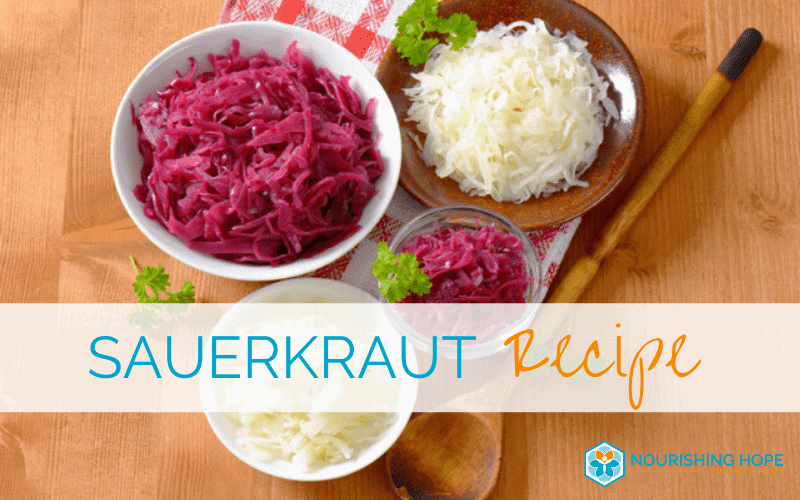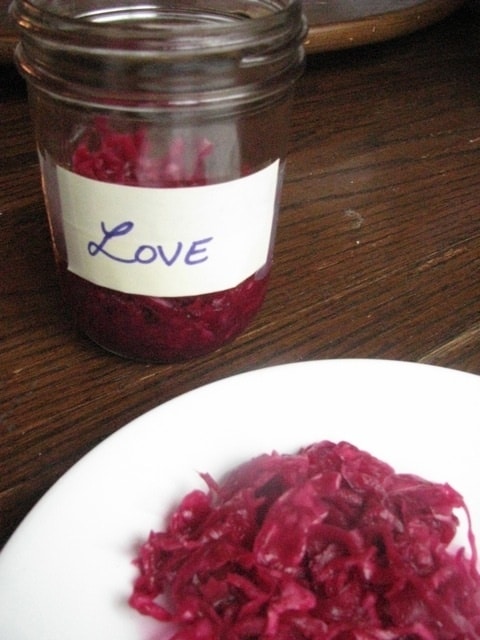
GFCF/SCD/GAPS/Paleo/LOD/BED/Keto Diet Compliance
Sauerkraut is wonderful for digestion and the immune system. It’s also beneficial for our mood.
Sauerkraut is made with fermented or cultured cabbage and other vegetables. When they are made raw, the traditional way, they contain live bacteria that aid our digestive health, as well as our brain and immune system. Since sauerkraut is rich in probiotics, it supports a balanced, healthy microbiome and good health.
Sauerkraut is rich in probiotics, which supports a balanced healthy microbiome and good health. And it’s never too early to start. See my daughter below at 10 months old.
It’s easy to make and a really fun experiment with kids when you’re home with free time on your hands. All you need is a cabbage, some salt, and time.
Supplies
- Ceramic crock and a plate or other jar that fits inside crock to hold the cabbage down
- 1 quart or 2 liter jar filled with water (scrub the outside)
- Cloth cover such as muslin or kitchen towel
Ingredients
- 5 lbs/2 kilograms cabbage (Green or red/purple)
- 3 tablespoons/45 milliliters sea salt
Instructions
- Rinse cabbage. Retain two outer cabbage leaves. Grate cabbage by hand with mandolin or in food processor, finely or coarsely.
- Place cabbage in bowl. Sprinkle salt on cabbage as you go. The salt pulls water out of cabbage and creates the brine so it can ferment and sour without rotting. The salt also keeps the cabbage crunchy by inhibiting organisms and enzymes that soften it.
- You can add other vegetables such as carrots, ginger, radishes, onions, garlic, leafy greens, seaweed, beets, turnips and burdock roots. Juniper berries are common. For consistent results, I typically use a majority (75%) cabbage with some of these other vegetables for flavor and variety. You can try almost anything, but without a starter, vegetables containing natural lactobacillus are the best such as cabbage and root vegetables including beets, radishes, turnips, and carrots.
- Mix ingredients and pack into crock. Pack a small amount into the crock a little at a time and tamp it down with your fist or a kitchen implement like a potato masher. You can also massage cabbage with your hands, and then tamp down. The goal is to force water out of cabbage, pack the kraut tightly, and press out any air. If you’d like, you can place a cabbage heart (the center of the cabbage) in the center of the sauerkraut in the crock. The center pickles and leaves you with very crispy, crunchy cabbage that you can eat with your fingers—this is often fun for children.
- Place cabbage leaves in crock on top of packed cabbage to keep any shredded cabbage from floating to the surface of the water. Place the plate over the leaves to keep everything down. Add a weighted jar (filled with water works) to top to act as a weight. The goal is to keep EVERYTHING (except the jar) under water. The water is formed by the liquid in the cabbage and the salt. Let it sit for 6 hours or so and see if the water line rises above the cabbage. If there is not an inch and a half of water, add salt water in the ratio of 1 tablespoon salt to 1 cup of water. Salt inhibits mold growth, but too much salt slows good bacteria. As such, you want to be fairly accurate with your salt/cabbage and salt water proportions.
- Cover with fabric cloth and tie with a string or large rubber band. Make sure it goes all the way around so no bugs can get it.
- If you use a Harsch crock, the process (in steps 5 and 6) is simple. Instead of needing a plate and weight, specially made weights are included. Place the plates on top of the cabbage making sure the water is over the top of the vegetables. Place lid on top and fill rim with water to form water seal. No fabric is necessary.
- Ferment for 2-8 weeks or more. Personally, I like long ferments of 8 weeks or more. Because my home (in San Francisco) is very cool all year round (resembling a cellar), the kraut turns out great every time. Always sour and crunchy. Never soft.
The types and amounts of bacteria differ in the raw sauerkraut as the fermentation changes over time. For this reason, I like Sandor Katz’s suggestion of “eating it as you go.” Make a large batch. After two weeks, “harvest” one jar or one week’s worth. Pack the sauerkraut back up and set aside to ferment. After that jar is finished, harvest another jar in the next week. Continue for eight to ten weeks or whenever it is done. This ensures that you get the various bacteria types and counts over time.
Additional notes:
- If you live in a warm climate, you will want to invest in a Harsch crock. They help insulate the sauerkraut with its thick ceramic. The crock keeps the kraut from getting mushy in hot weather. The weighted “plate” inside with an air tight water sealed lid keeps air out but allows gasses to escape.
- You can make sauerkraut with whey but it is not necessary and I’ve never noticed any difference either way. More importantly, whey is from yogurt and contains casein—something many people are trying to avoid with sauerkraut. You can also use a cultured vegetable starter such as the one Donna Gates has on BodyEcology.com. I like to do things the “old fashioned way” without a starter—it feels empowering.
- There is another method seen in books and online. This method typically doesn’t weight the sauerkraut down, they use a starter, an airtight lid, and only ferment them 3-7 days. Be aware not to use this method for long ferments; otherwise, you will blow the top of your ferment.
Variation and note on salt: You can use half the salt by substituting seeds (an even mix of celery, caraway, and dill). Although, the original recipe uses only salt, it is not “salty” in taste—especially the longer it ferments.
*I adapted this recipe from Sandor Katz’s sauerkraut recipe and his book, Wild Fermentation. This is one of my favorite books on fermenting everything. And he has a new book, The Art of Fermentation.
Here’s a photo of my daughter at 10 months, eating cultured vegetables. And my “intention kraut” where I write my desired intention on the jar and I believe the good bacteria help me put the good energy in the sauerkraut. Here’s my batch of Love Kraut.
Share your experience, comments, and questions on sauerkraut with us.
18 servings
35 minutes






0 Comments